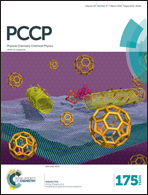Intramolecular charge transfer in aminobenzonitriles and tetrafluoro counterparts: fluorescence explained by competition between low lying excited states and radiationless deactivation. Part II: influence of substitution on luminescence patterns†
Abstract
In this paper, we study the mechanisms of charge transfer, luminescence and radiationless decay of three derivatives of 4-aminobenzonitrile (ABN): dimethyl-ABN (DMABN) and the tetrafluorinated derivatives, ABN-4F and DMABN-4F. Our CASSCF/CASPT2 computations explain the different luminescence patterns observed in these three compounds and in comparison with the parent system, ABN, in spite of their similar architecture. We have found that the modifications made by the different substitutions in ABN tune the relative energies of the locally excited (LE) and charge transfer (CT) excited states due to electronic and structural factors. In all cases, the only potentially emitting species of CT character is the twisted-ICT. The increasing stabilization of this later species in the series formed by ABN-4F, DMABN and DMABN-4F explains the increasing intensity of the anomalous emission band in these compounds. Nevertheless, other factors like probability of emission vs. nonradiative decay must have also been taken into account. In fact fluoro-substitution increases the accessibility to conical intersections of the excited states with the ground state, opening an internal conversion channel that decreases the fluorescence quantum yield in the fluorinated derivatives. Our results also show that the involvement of the π–σ* state in the CT process is only possible in ABN-4F, but even in this case it is not probable.


 Please wait while we load your content...
Please wait while we load your content...